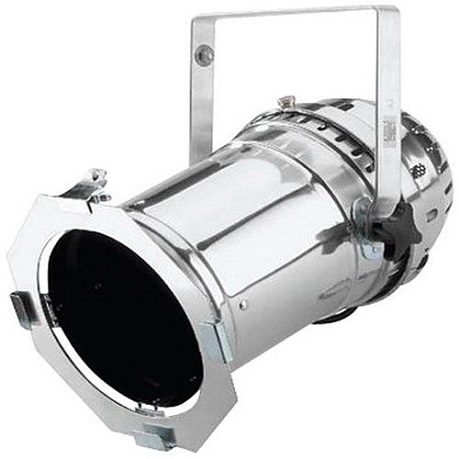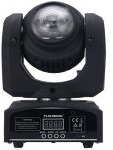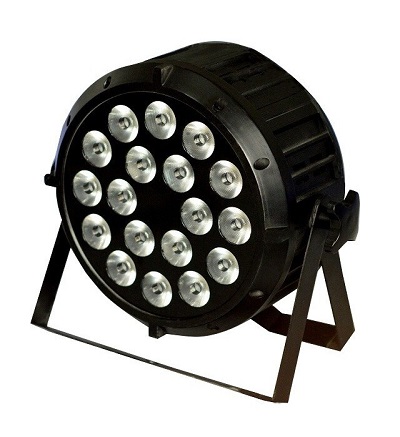Floodlight. Floodlights are designed to illuminate distant objects or provide long-range signaling.
Light sources are typically equipped with optical devices that create the required light distribution. Redistribution of the light flux from the light source can be achieved through reflection from mirrored surfaces, refraction by prisms and lenses, as well as by using reflective and refractive light elements. For instance, to create highly directional emission, a parabolic reflector is utilized, and the light source of very high brightness is placed at its focal point, F.

A floodlight is a device that can serve both for indoor lighting (e.g., a garage bay) and for outdoor illumination, provided it has a high degree of environmental protection.
Types of Floodlights By lamp type:
- LED
- Metal Halide
- Xenon
- Mercury Vapor
- Plasma
- Incandescent
- Infrared
By application:
- Theatrical
- Іndustrial
LED Floodlight
An LED floodlight consists of components such as the housing, protective glass, LED (the key element of the floodlight), reflector or reflector, silicone protection, clamp, driver, mounting bracket, or “ear.” The primary elements of the floodlight are the LED itself and the driver. LED floodlights are designed for outdoor use and typically have an IP65 protection rating, indicating dust and moisture resistance. There are two main types of LED floodlights: COB and SMD. SMD LEDs
SMD (Surface-Mounted Device) LEDs involve directly connecting the solder of the substrate’s contact pads to the mounting board. SMD LEDs are placed closely together on the board, usually several times larger than the linear dimensions of the crystals. One drawback of SMD LEDs is that they have a more complex structure when repairs are needed. It’s possible to solder an SMD diode, but special equipment is required. COB LEDs
The next step in floodlight development was the Chip-on-Board (COB) technology. COB means “numerous crystals on a substrate.” This technology involves placing crystals on a board without housings and ceramic substrates, covering these diodes with a common phosphor layer. Thanks to this, the cost of LED matrices is significantly reduced. COB LEDs are positioned much closer to each other than SMD LEDs. The density of placement can reach up to 80 crystals per square centimeter. They have a common phosphor coating, which means COB matrices emit light uniformly, with individual points being almost invisible.
LED floodlights come in several types: regular floodlights, motion sensor floodlights, solar-powered floodlights, and portable floodlights. They differ in construction and may have additional functions. Regular LED Floodlight
A regular LED floodlight has no additional features or unique construction. Its sole function is to emit light. Motion Sensor Floodlight
This floodlight includes a motion sensor in its construction, which activates the light when motion is detected within its range. The motion sensor uses infrared rays to detect movement.
When installing such an LED floodlight, it’s essential to consider the motion sensor’s range. Solar-Powered Floodlight
This type of floodlight doesn’t require connection to the power grid. It only needs proper placement so that the solar panel receives as much sunlight as possible. Solar-powered floodlights consist of the floodlight itself, a solar panel, a battery, and often have a remote control to adjust brightness, set operating times, or turn it off. Portable Floodlight
A portable floodlight either has a built-in battery or a long power cord for grid connection. They are used in situations where permanent lighting installation is unnecessary, such as construction sites or workshops. The advantage is that you can move it to another location where needed.
Metal Halide Floodlight
The operation principle of such a device is as follows: a gas discharge lamp filled with gas emits light when switched on. This floodlight provides bright, cool-toned light.
Metal Halide Lamps (MHL) are a type of high-pressure gas discharge lamp. They differ from other high-pressure gas discharge lamps because they use specific additives of metal halides to correct the spectral characteristics of the arc discharge in mercury vapor.
Xenon Floodlight
A xenon arc lamp is an artificial light source in which an electric arc in a bulb filled with xenon gas produces light. It emits bright white light closely resembling daylight in spectrum.
The lamp consists of a bulb made of ordinary or quartz glass with tungsten electrodes. The bulb is evacuated and then filled with xenon gas.
Mercury Vapor Floodlight
Mercury vapor gas discharge lamps are electric light sources that use a gas discharge in mercury vapor to produce optical radiation. Mercury vapor lamps are a type of gas discharge lamp. To name all types of such light sources in domestic lighting technology, the term “discharge lamp” (DL) is used.
Plasma Floodlight
Plasma floodlights are designed for illuminating indoor and outdoor areas with a height of more than 6 meters, where it is challenging to implement lighting by other means.
Incandescent Floodlight
Light is emitted from a heated body that is electrically charged to a high temperature. Typically, this type of lighting is less desirable as it generates excess heat, making it less energy-efficient.
Infrared Floodlight
Infrared floodlights emit a spectrum of light that is invisible to the human eye. Infrared floodlights are used in video surveillance systems and devices used for nighttime illumination. While the human eye cannot detect infrared light, cameras capture it clearly and comprehensively.
Theatrical Floodlights
A theatrical floodlight is a professional directional lighting device with varying levels of power. The light from a floodlight allows for illuminating and emphasizing specific elements on a stage. Floodlights used for theatrical lighting come in different types depending on their purpose and have their own mounting styles.
Types of theatrical floodlights:
- Single-Lens Floodlights
- Low-Voltage
- Parabolic Reflectors (Par Cans)
- Profile Spotlights
- Followspots
- Scanners
- Moving Heads
- Color Changers
Single-Lens Floodlights
A single-lens floodlight is an optical device consisting of a light source, a spherical reflector, and a flat-convex lens that serves as the objective. The primary drawback is chromatic aberration, resulting in a rainbow-like halo at the edge of the light beam due to dispersion.

Low-Voltage Floodlights
These floodlights are designed to create a narrow beam with high luminous flux. The lamp is placed in an opening in the reflector. Since the reflector has significant dimensions, there is a possibility of parasitic illumination, unwanted reflections from the device. To eliminate reflections, a sun visor is installed. The drawback is the need to use reducing transformers, which increase the weight of the device.
Parabolic Reflectors (Par Cans)
Parabolic reflectors or PAR cans with a spotlight lamp have the same optical scheme as low-voltage floodlights. The reflector is an integral part of the lamp bulb and is not part of the device’s housing. It is called a spotlight lamp.


Profile Spotlights
Profile spotlights allow creating a specified beam profile using blade-like shutters and an iris diaphragm located inside the floodlight’s housing. This allows for creating beams of various shapes, such as rectangular or trapezoidal. Special plates, called gobos, are used as templates. They can be made of metal, glass, colored or monochrome.

Followspots
Followspots or light cannons are used to highlight performers, putting a light focus on them. Modern followspots have color-changing and brightness adjustment systems, but most are operated manually. These floodlights have a housing that can be controlled to follow the artist and provide a high brightness light beam.


Scanners
The main feature of scanners is their beam positioning system, consisting of a light source, lens systems, and a scanning mirror. The mirror reflects the light emitted by the light source and transformed by the lenses. The angle of the mirror’s tilt relative to the direction of the light beam determines the angle of reflection. The mirror can change its position both vertically and horizontally using a special mechanism. The mechanism is controlled from a lighting console. Scanners often come with devices that can change the beam’s color and shape, allowing for dynamic effects.

Moving Heads
Moving heads replicate the capabilities of scanners but differ in construction. In the case of a scanner, the mirror moves, while in moving heads, the entire floodlight housing moves. This movement occurs in both the horizontal and vertical planes, covering a 360-degree range in both the X and Y axes. These devices may also have additional functions, such as automatic color changes and more. Prisms and gobos are used to change the beam’s shape, enabling dynamic effects.

Color Changers
Color changers are luminaires with the ability to automatically change colors. They are used in stage lighting. Such devices often have a CMY color mixing system, allowing for precise color control down to the hue.

Industrial Floodlights
Industrial floodlights are used for illuminating construction sites, factories, and workshops. These floodlights have a high degree of protection against dust and moisture since industrial environments typically have more dust, moisture, and vapors from substances used in production.
One of the main criteria for industrial floodlights is their power, which depends on the area that needs to be illuminated.